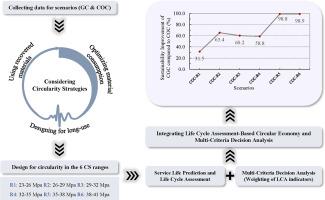Beyond carbon: An integrated LCA–MCDA framework for circularity measurement of ordinary and geopolymer concrete
IF 11.2
1区 社会学
Q1 ENVIRONMENTAL STUDIES
引用次数: 0
Abstract
In recent years, circular approaches to concrete production have gained increasing attention, yet comparative evaluations between different circular concrete types remain limited and inconsistent. In this context, previous comparative studies between circular ordinary concrete (COC) and circular geopolymer concrete (CGC) have been hindered by biases, including a narrow focus on carbon emissions, neglect of service life differences, and inconsistent compressive strength (CS) comparisons. This study presents a novel integrated framework that combines life cycle assessment (LCA), circular economy strategies, and multi-criteria decision analysis (MCDA) to robustly evaluate the sustainability of COC and CGC across six CS ranges. The case study is based in Tehran, reflecting local material availability, environmental conditions, and priorities, influencing mixture designs and MCDA weightings. This underscores the necessity of region-specific approaches in sustainability assessments. Accordingly, circular mixtures were optimized using response surface methodology (RSM), service life was incorporated via the fib model, and a cradle-to-cradle LCA was performed. MCDA, informed by local expert opinions, prioritized environmental indicators. Results demonstrate that CGC consistently outperforms COC across all examined CS ranges (23–41 MPa), with its sustainability performance improving at higher CS. This advantage is attributed to CGC's lower sensitivity to CS-related environmental burdens and substantially longer service life. Moreover, circularity metrics confirm the benefits of circular designs over linear alternatives, with resource inflow circularity rates of approximately 88 % for COC and 71 % for CGC. This research provides a comprehensive decision-making tool by emphasizing the need for holistic and context-specific assessments to advance circularity in the concrete construction industry.

超越碳:用于普通和地聚合物混凝土圆度测量的集成LCA-MCDA框架
近年来,循环混凝土生产方法越来越受到关注,但不同循环混凝土类型之间的比较评价仍然有限和不一致。在此背景下,之前的圆形普通混凝土(COC)和圆形地聚合物混凝土(CGC)之间的比较研究受到偏见的阻碍,包括对碳排放的狭隘关注,忽视使用寿命差异,以及不一致的抗压强度(CS)比较。本研究提出了一个新的集成框架,将生命周期评估(LCA)、循环经济战略和多标准决策分析(MCDA)相结合,在六个CS范围内对COC和CGC的可持续性进行稳健评估。该案例研究基于德黑兰,反映了当地材料的可用性、环境条件和优先事项,影响了混合设计和MCDA权重。这强调了在可持续性评估中采取具体区域办法的必要性。基于此,采用响应面法(RSM)对循环混合料进行了优化,通过fib模型纳入了循环混合料的使用寿命,并进行了从摇篮到摇篮的LCA分析。MCDA根据当地专家的意见,优先考虑环境指标。结果表明,CGC在所有测试的CS范围内(23-41 MPa)始终优于COC,并且在更高的CS下其可持续性性能有所提高。这一优势归因于CGC对cs相关环境负担的敏感性较低,使用寿命大大延长。此外,循环度指标证实了循环设计优于线性替代方案的好处,COC的资源流入循环率约为88%,CGC的资源流入循环率约为71%。本研究提供了一个全面的决策工具,强调需要整体和具体情况的评估,以推进循环在混凝土建筑行业。
本文章由计算机程序翻译,如有差异,请以英文原文为准。
求助全文
约1分钟内获得全文
求助全文
来源期刊

Environmental Impact Assessment Review
ENVIRONMENTAL STUDIES-
CiteScore
12.60
自引率
10.10%
发文量
200
审稿时长
33 days
期刊介绍:
Environmental Impact Assessment Review is an interdisciplinary journal that serves a global audience of practitioners, policymakers, and academics involved in assessing the environmental impact of policies, projects, processes, and products. The journal focuses on innovative theory and practice in environmental impact assessment (EIA). Papers are expected to present innovative ideas, be topical, and coherent. The journal emphasizes concepts, methods, techniques, approaches, and systems related to EIA theory and practice.
 求助内容:
求助内容: 应助结果提醒方式:
应助结果提醒方式:


